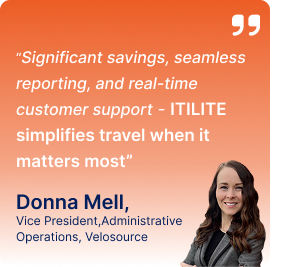
The increase in the younger generation Z workforce is significantly impacting how companies manage business travel. Unmanaged travel programs are rapidly evolving into managed, and obsolete spreadsheet-based business travel management practices are making way for state-of-the-art business travel software solutions.
Travel managers are focussing on finding solutions that can empower employees to book travel seamlessly while considering company objectives. But while hunting for suitable business travel software, what factors can you look for during business travel software demo or trials to determine if the solution fits your company’s needs?
In this guide, we will walk you through the best practices for executing a successful business travel software trial.
1. Clearly Define ‘S.M.A.R.T’ Objectives
Before starting the trial, clearly define KPIs and their targets, which will determine if the pilot is successful. Make sure that your goals are S.M.A.R.T., which means specific, measurable, attainable, relevant, and time-bound.
For instance, if your goal is to improve user experience, merely stating that the software should provide “good UX” is not enough. You should define key metrics, such as the following.
User Satisfaction: Measure user satisfaction through a survey. Keep the survey limited to 3 questions –
- How likely are you to recommend this software to a new colleague?
- What did you like most about the software?
- What did you not like about the software?
- Aim to achieve a user rating of 4.5/5.
Adoption Rate: This metric measures the percentage of users who successfully completed their bookings using the software. Aim to hit at least 70% adoption, as that strongly correlates to successful launches.
Time Taken to Book: This metric measures the time it takes for a user to complete their booking. A reduction in ‘time taken to book’ indicates a more efficient and user-friendly interface, especially if you are moving from another software.
Error Rate: The error rate measures the frequency of user errors or mistakes encountered during booking completion. A lower error rate suggests a more intuitive software design.
Tracking and measuring these metrics will help you evaluate the travel software’s effectiveness and determine if it can work for your company.
2. Choose the pilot users wisely
Selecting the correct set of users for the pilot is critical to its outcome. Our research suggests that users who are pro-technology are the best fit for a software trial. In addition, we recommend that:
- The pilot should be run with at least 10 travelers to get good unbiased feedback
- Ensure these travelers have at least 2 trips coming up within the pilot period
- Avoid CXOs or any other low patience users
3. Secure buy-in from Key Stakeholders
At the beginning of the trial, set up a panel of the CFO, CHRO, Office Manager, and the Head of a Team that travels frequently. Align them with the S.M.A.R.T goals for the pilot. Don’t forget to determine their expectations as Administrators. For instance, CFO and CHRO are often concerned if:
- Can data reports be set up in a format that the company uses currently?
- Can approval rules be set up without change?
Include all critical stakeholders who will have a vote on buying and rolling out the software.
Overinvest in the panel at the beginning of the pilot since this will ensure unity of command and a faster roll-out if the pilot is successful.
4. Create Buzz
Remember that every change is hard. Most pilots fail because users never try out the software. Therefore, don’t forget to market the pilot internally.
Run awareness campaigns to highlight the advantages of adopting the software. Create social reinforcement by publishing the positive experiences of users within the company. If a majority of trial users understand that the travel software has potential to make their life simpler, they will willingly participate in the trial and help identify the best software for you.
5. Ensure Process Remains Unchanged
While introducing the software, it is important to make sure that the process remains similar to your current process. This ensures that the users don’t get confused, and prevents them from reviewing the process, instead of the software.
Two important tips –
- Keep the approval process the same. That is, don’t add approval just because you can
- Include all preferred hotels, even for the pilot
6. Gather User Feedback Smartly
User feedback is invaluable in understanding how well the software meets user expectations. However, not every user is fit to provide feedback. It is common for users who haven’t used the software to also give feedback!
As the pilot owner, ensure you focus on feedback from users who have actually used the software and disregard other feedback. This will prevent incorrect decision-making based on flawed feedback.
If you are running a long user experience survey, you should make sure that:
- The survey is properly formatted
- Questions are close-ended. E.g., “Were you naturally able to find the tab to make the bookings?” or “How long did the support team take to respond to your inquiry via chat?”
- You are using at most two open-ended questions. E.g., “Enlist X improvement areas you see?”
This will ensure your feedback analysis is accurate and doesn’t drain your time.
7. Conduct Comparative Analyses
To select the right software, running parallel trials and conducting comparative analyses of multiple solutions is essential. This will help you assess the unique features, advantages, and drawbacks. You can also evaluate cost and pricing structures, calculate the ROI and make an informed decision.
Try ITILITE Business Travel Software
In conclusion, executing a successful business travel software trial requires careful corporate travel planning and meticulous execution. By following the best practices outlined in this guide, you can ensure that the trial effectively evaluates the software’s suitability for your company’s needs.
If you are looking for world-class travel software, try ITILITE. Its corporate travel management platform can help you book flights, hotels, and car rentals conveniently, eliminate data reporting headaches, get the fastest customer support whenever you need it, and save you money too. If you want to learn more about our advanced features, our travel experts can give you a thorough tour.
What’s more? You get the trial for FREE. So, what are you waiting for? Book a free business travel software demo of ITILITE today.








